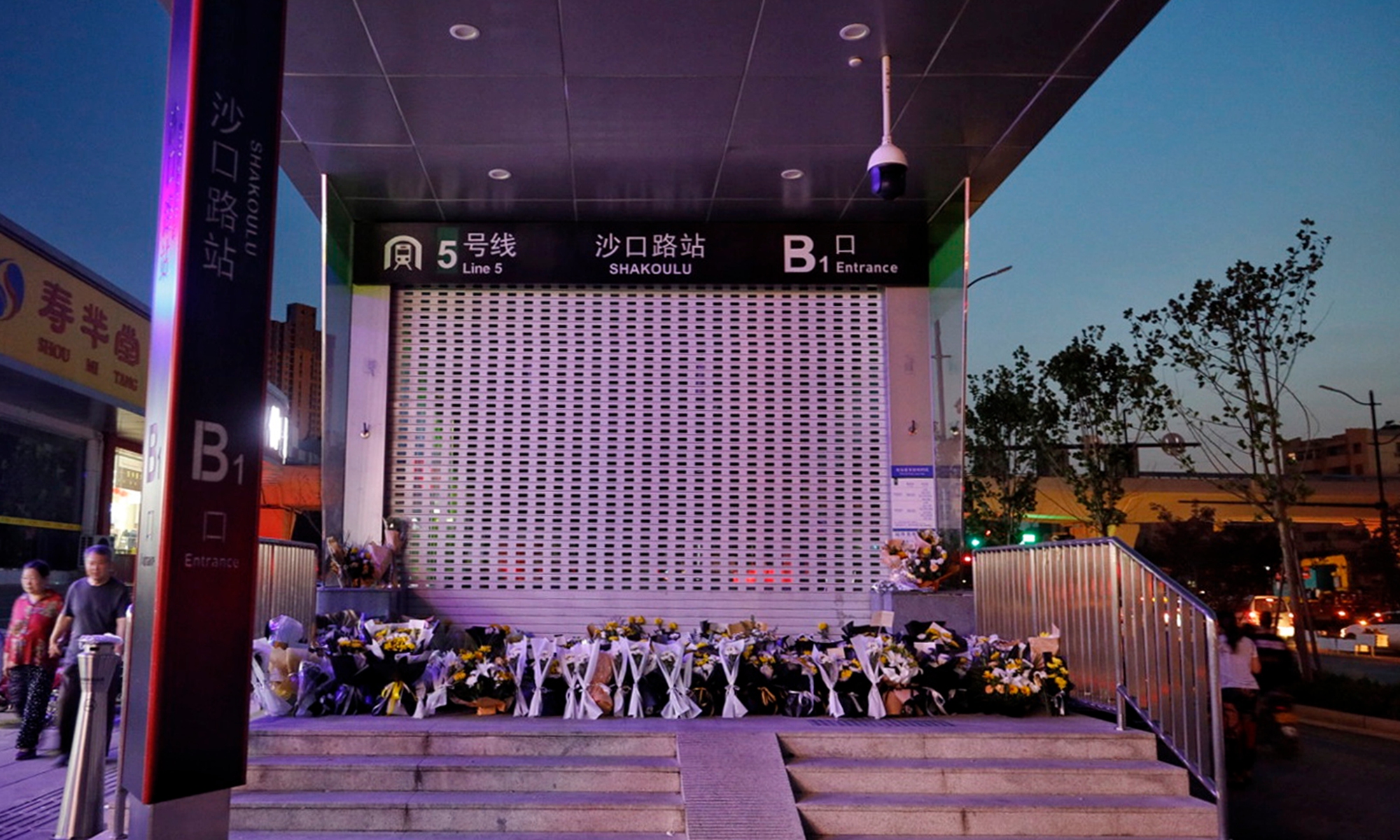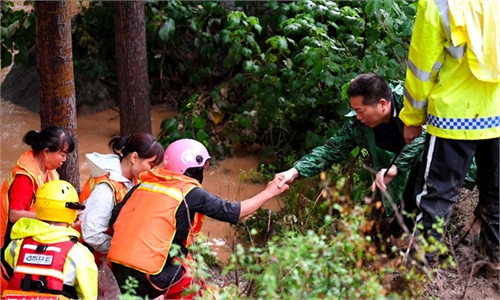Update: Decisive actions urged to shut down subways in emergency as death toll in Zhengzhou subway flood rises to 14

Residents in Zhengzhou, Central China's Henan Province laid flowers to mourn the dead in the flooded line 5 subway at the line's Shakou Road exit. Photo: Li Hao/GT
Multiple government agencies and local authorities in various places across the country are ramping up efforts to make sure effective measures will be in place to ensure people's safety in subways and tunnels in case of emergencies as Chinese Premier has urged decisive actions to be taken to shut down subways and tunnels against emergencies.
The death toll from the subway flood tragedy on July 20 in Zhengzhou, Central China's Henan Province, caused by torrential rainfall, has risen to a total of 14 after two more bodies were recovered, the local government said on Tuesday. The tragedy drew reflections nationwide that decisive measures and precautions must be taken to avoid similar misfortune.
Chinese Premier Li Keqiang urged for stricter response measures to be taken to enhance safety in densely populated cities such as on subways, in tunnels, and other underground spaces at a video conference at the State Flood Control and Drought Relief Headquarters on Monday after continuous heavy rainfall hit Henan Province and other regions.
Decisive actions should be taken to suspend work, school classes and business operations except for special industries in case of emergencies, Li stressed.
Effective measures must be taken to ensure people's safety in subways and tunnels, and these facilities should be shut down in a timely manner in case of emergencies, he said.
On July 20, water inundated Line 5 of the Zhengzhou Metro, one of the busiest lines in the city, forcing the train to stop between Shakou Road Station and Haitansi Station. More than 500 passengers on board were trapped in neck-deep water for nearly four hours. Fourteen people died after torrential rains flooded the subway.
Regions across the country that have also been hit by heavy rains in recent days are learning from the tragedy in Line 5 and acting swiftly to get ready for emergency deployment.
Beijing Municipal Government stressed the delegation of the power to grass-root frontline personnel to deal with emergencies decisively and urged the resolute measures to be taken including suspending work, school, and subways in emergencies, the Beijing Daily reported on Wednesday, citing a Beijing government executive meeting held on Tuesday.
Other regions including East China's Shanghai, Zhejiang Province and Anhui Province made similar moves to make sure effective measures will be taken to deal with emergencies.
Days after the flooded metro tragedy in Zhengzhou, rescuers have been screening related areas and have found no more fatalities or casualties, the Zhengzhou government said Tuesday. Wang Kai, Governor of Henan Province, inspected the Line 5 repair works progress on Monday and analyzed the plan for the next phase with the public security and fire departments.
Unprecedentedly heavy rain on July 20 caused perilous water logging in the railway's Line 5 Wulongkou depot and other surrounding areas. The water flowed the retaining wall set in the depot and soon poured into the coach soon caused perilous water logging
The Global Times visited the Wulongkou parking lot on Thursday and found it was an above-ground place for train maintenance. A construction worker told the Global Times that a water retaining wall was placed between the parking area and the underground track of the line, and its height reflected maximum local rain amounts over past decades.
From 8 pm on July 18 to 8 pm on July 20, precipitation in Zhengzhou had reached 617.1 millimeters with hourly and daily precipitation both breaking 60-year records, according to media reports.
A Global Times reporter was not able to get close to the water retaining wall for a firsthand inspection as it was closed for dredging.
Families of the victims and netizens called for thorough investigations, and demanded for a response for what could have possibly accelerated the situation, which they said had aggravated the disaster.
Subway working regulations require the railway staff to immediately take emergency measures and launch an evacuation if there is waterlogging in the subway.
Once it reaches a warning level, a pump underground should automatically start drainage.
But with waist-high water on the ground outside at that moment, there was no room to drain water out through the pumps, analysts said.
The extreme rainfall was clearly beyond the capacity of the subway's construction design and emergency measures, the construction worker said, adding that the unprecedented situation paralyzed the city's subway lines' operation and emergency plans.
On Monday, the wife of a victim released a Weibo post, accusing the Zhengzhou Metro of serious dereliction of duty during the tragedy.
"Zhengzhou Metro must take the responsibility for the accident. It failed to make full preparations before the flood; allowed Line 5 to operate while some other lines had been damaged by the flood; failed to evacuate passengers promptly after floods rushed into the line. This led to passengers being trapped for about an hour. It also failed to report the accident and launch rescue work in a timely way," read the post.
On July 20, the Zhengzhou meteorological department issued a total of 10 red alerts for rainstorms. As the highest warning signal, red signal defense guidelines require the suspension of rallies, classes and business (except for special industries), and all emergency responses are required. But it did not raise the government's alarm.
Some Zhengzhou residents reached by the Global Times said that they did not receive notices of school or business suspensions until July 21, and many people continued to commute as usual.
According to the reports, the Line 5 passengers were trapped for nearly four hours after sending SOS messages, along with self-rescue attempts.
The Zhengzhou Fire Rescue Detachment command center said it received calls for help from passengers at around 6 pm on July 20, and dispatched rescue workers soon. However, due to barriers at some parts of the tunnel that were under maintenance, firefighters ultimately used rescue ropes to create a bridge to guide people out.
Analysts said such unprecedentedly massive rainfall in Zhengzhou overwhelmed the capability of its drainage infrastructure and inundation was unavoidable. Metro authorities in Zhengzhou may have deliberated different options on how to transport passengers on the busiest route to safety in peak hours during the massive downpour.
Wang Hongwei, a professor at Renmin University's China School of Public Administration and Policy, told the Global Times that Zhengzhou authorities must have prepared for the rainstorm, but the impact of the rain was way beyond their expectations.
It is still not clear whether there was a delay in the administrative procedure of the decision whether to suspend the subway, but a lesson we can learn from the tragedy is that related authorities in the Zhengzhou subway may decentralize power to the lower levels to ensure a quick response, Wang noted.


